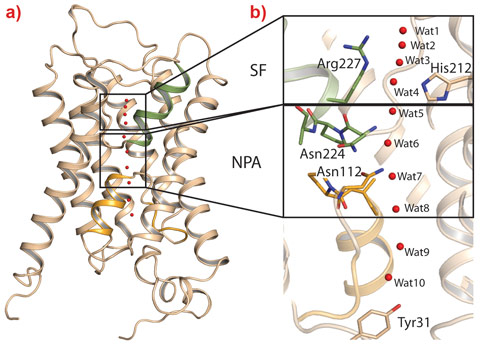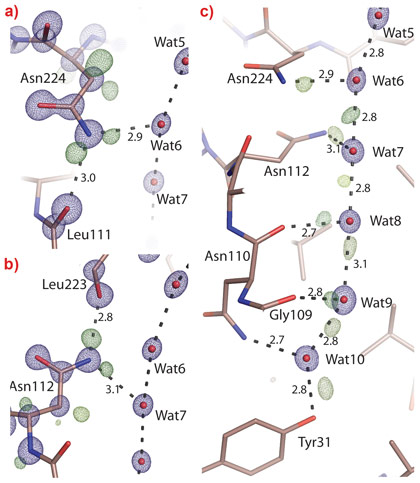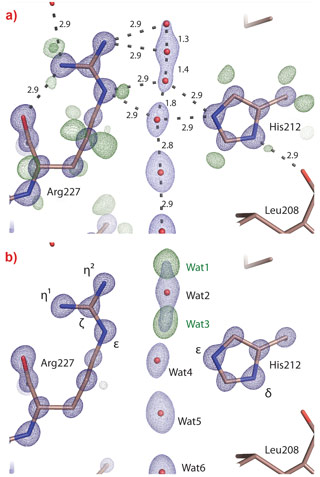- Home
- News
- Spotlight on Science
- Cellular water transport:...
Cellular water transport: atomic level insight provided by the first sub-angstrom resolution crystal structure of a membrane protein
17-09-2013
Membrane proteins involved in homeostasis must be extremely selective for the molecule they transport. Aquaporins facilitate water transport in living cells while excluding ions and other molecules. The first sub-angstrom resolution crystal structure analysis of a membrane protein provides atomic level insight into the mechanisms, including specificity, of cellular water transport, with unambiguous assignment of amino acid side chain orientation and tautomeric form.
Share
The control of water homeostasis in living cells is facilitated by aquaporins which, like all membrane proteins involved in homeostasis, have to be extremely selective for the molecule they are transporting. Thus, aquaporins must be able to exclude both hydroxide (OH-) and hydronium (H3O+) as well as preventing the transport of protons (H+) which can often be rapidly exchanged between water molecules linked by hydrogen bonds. The crystal structures of aquaporins from several species show that their tertiary structures comprise six transmembrane helices plus a pseudo helix, made up of two aligned half-helices inserted from opposite sides of the membrane, arranged to form a pore through which water can flow (Figure 1). The positioning of the pseudo helix places the dual asparagine-proline-alanine (NPA) motif characteristic of aquaporins close to the centre of the pore with specificity for water transport supplied by a so-called 'selectivity filter' found close to the extracellular pore entrance. The two half-helices making up the pseudo helix run in opposite directions and it has been proposed that the close approach of their N-termini provides a positively charged electrostatic barrier that orients the dipoles of water molecules passing though the pore in a way that prevents proton exchange between water molecules via a Grotthuss mechanism [1, 2] and thus also excludes the transport of H+ by aquaporins. However, this hypothesis does not explain the observation that reducing the strength of this electrostatic barrier increases the transport of Na+ by aquaporins but not that of H+ [3].
The ultra-high resolution (dmin = 0.88 Å) crystal structure, obtained using data collected at ESRF beamline ID29, of Aqy1 from Pichia pastoris has shed crucial light on the selectivity mechanisms of water transport by aquaporins. In particular, electron density and difference electron density maps (Figure 2) have allowed the unequivocal assignment of the orientations of both asparagine residues in the dual NPA motifs and confirm the proposed bipolar distribution of hydrogen bonds between adjacent water molecules being transported. Similarly, such electron density maps (Figure 3a) have allowed the assignment of both orientation and tautomeric form of two residues, His212 and Arg227, found in the selectivity filter and which are conserved in water-selective aquaporins. This has allowed a structural explanation as to how the transport of both H+ and H3O+ by aquaporins is inhibited.
Intriguingly, the electron density maps revealed apparently stable sites for four water molecules in the selectivity filter (Figure 3b). However, the distance between these positions excludes that all four sites can be occupied simultaneously. Indeed, the sub-angstrom resolution of the electron density maps obtained has allowed the conclusion that these four positions are actually made up of two pairs of sites (Wat2, Wat4; Wat1, Wat3) that are partially occupied in a mutually exclusive fashion (i.e. sites Wat2, Wat4 cannot be occupied at the same time as sites Wat1, Wat3). This suggests a pair-wise movement of water molecules through the aquaporin selectivity filter. This situation is analogous to the crystallographically observed pair-wise nature of K+ transport through potassium channels. As has also been proposed for potassium transport [4], the rather similar occupancy of the four water sites suggests that the binding energies of the 1,3 or 2,4 pairs are very similar, a situation which is ideal for maximising water conduction rates in aquaporins.
Principal publication and authors
Subangstrom resolution X-ray structure details aquaporin-water interactions, U.K. Eriksson (a) G. Fischer (a), R. Friemann (a), G. Enkavi (b), E. Tajkhorshid (b), R. Neutze (a), Science 340, 1346-1349 (2013).
(a) Department of Chemistry and Molecular Biology, University of Gothenburg, Göteborg (Sweden)
(b) Department of Biochemistry, College of Medicine, Center for Biophysics and Computational Biology, and Beckman Institute for Advanced Science and Technology, University of Illinois, Urbana, (USA)
References
[1] E. Tajkhorshid et al., Science 296, 525-530 (2002).
[2]. B.L. de Groot, T. Frigato, V. Helms, H. Grubmüller, J. Mol. Biol. 333, 279-293 (2003).
[3] D. Wree, B. Wu, T. Zeuthen, E. Beitz, FEBS J. 278, 740-748 (2011).
[4] J.H. Morais-Cabral, Y. Zhou, R. MacKinnon, Nature 414, 37-42 (2001).
Article written by G. Leonard, ESRF.
Top image: A region within the aquaporin structure acts as a selectivity filter, aiding the passage of water (red spheres) while preventing the transport of other molecules and ions.






